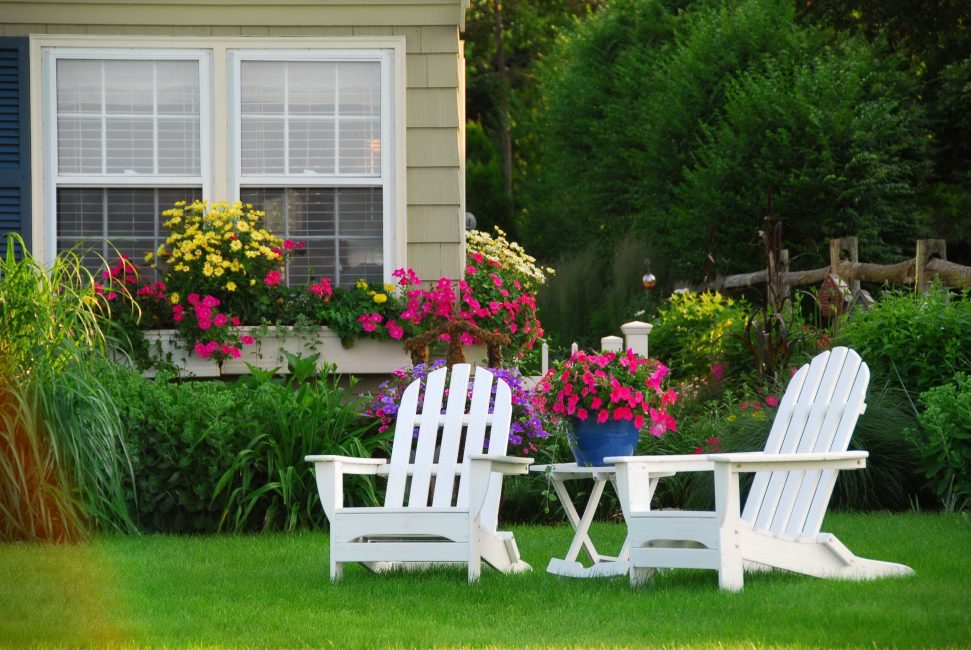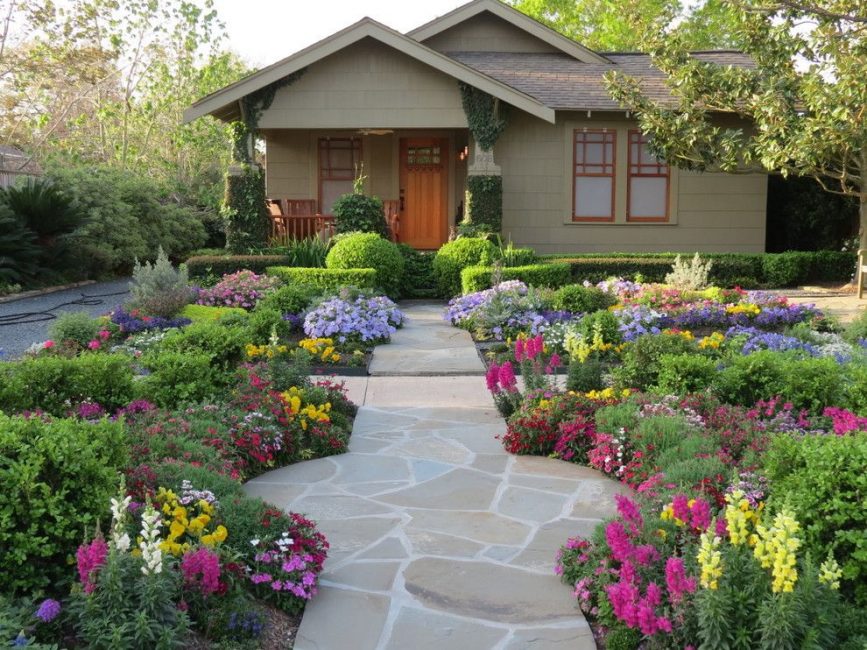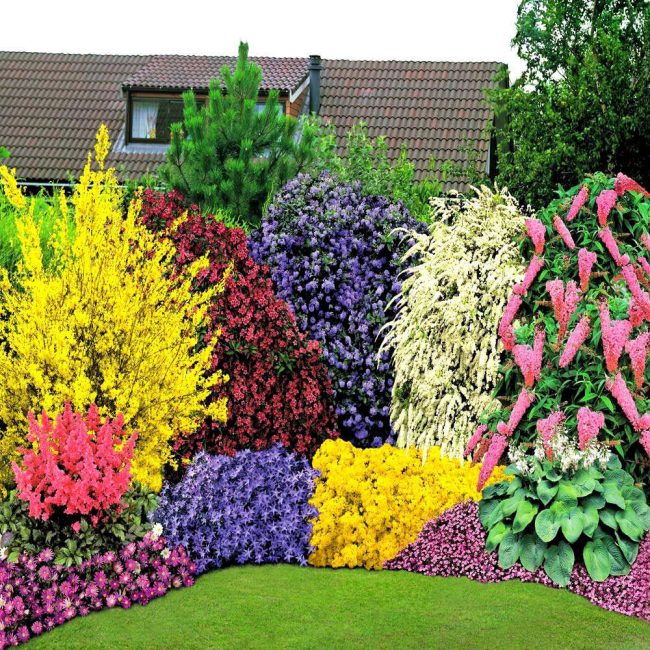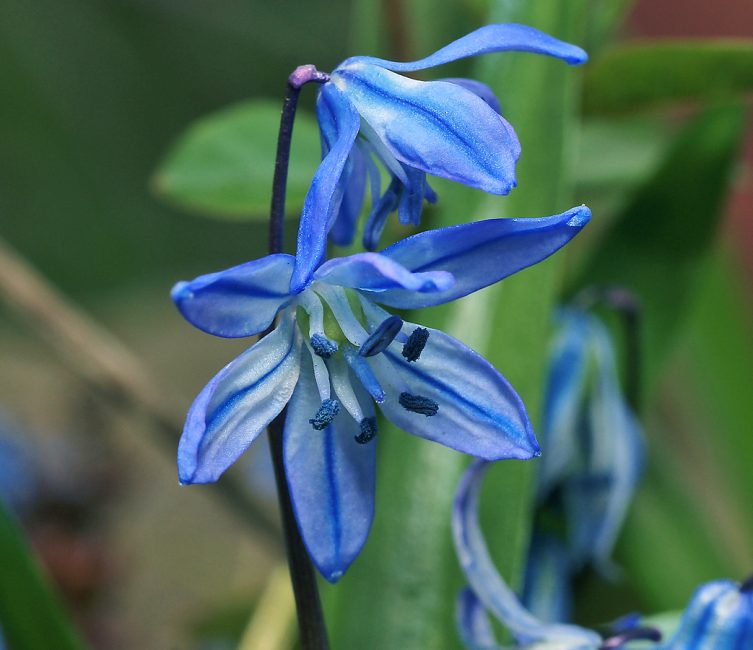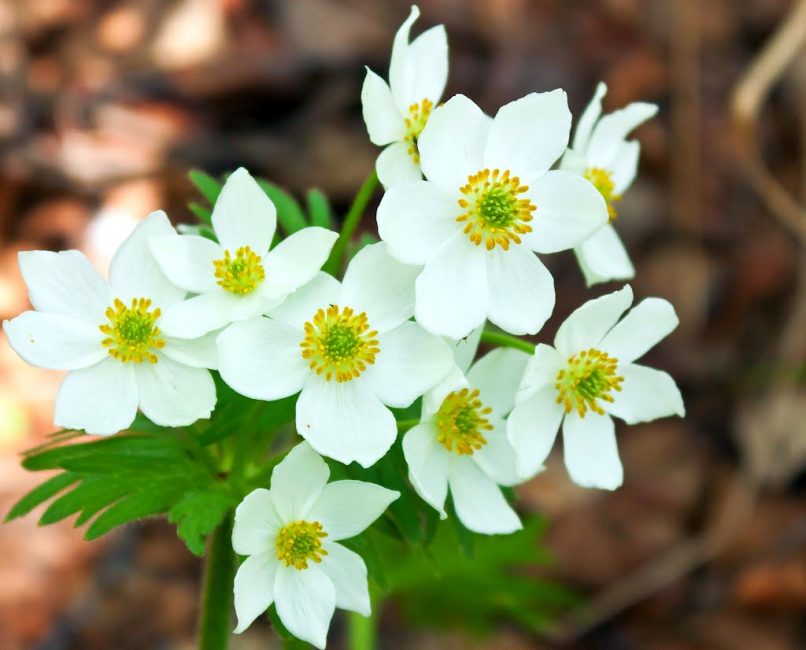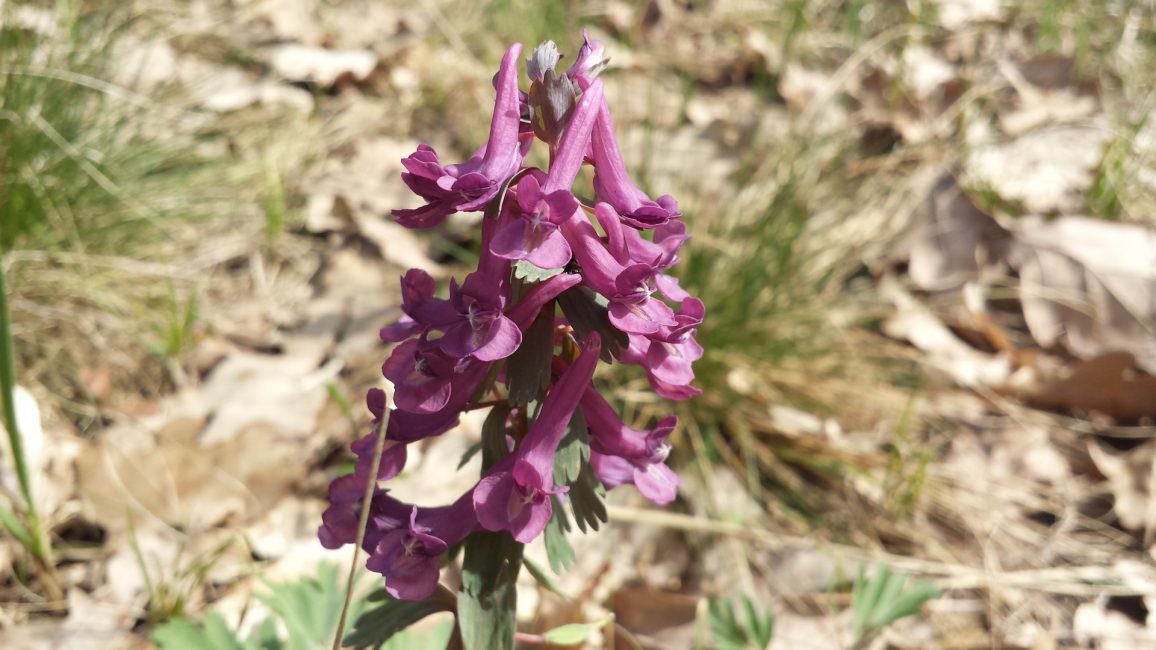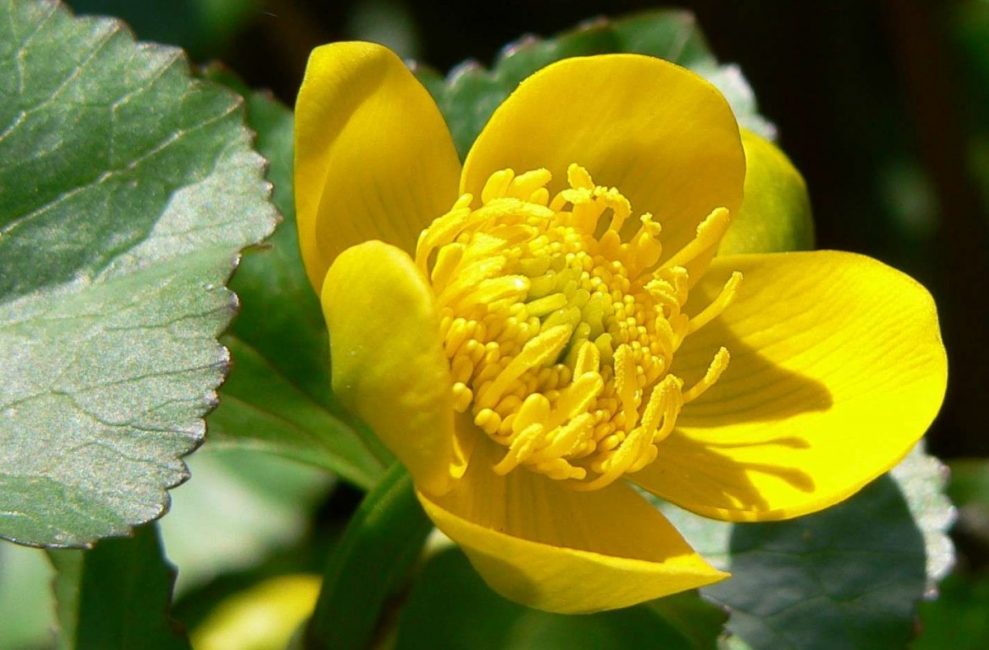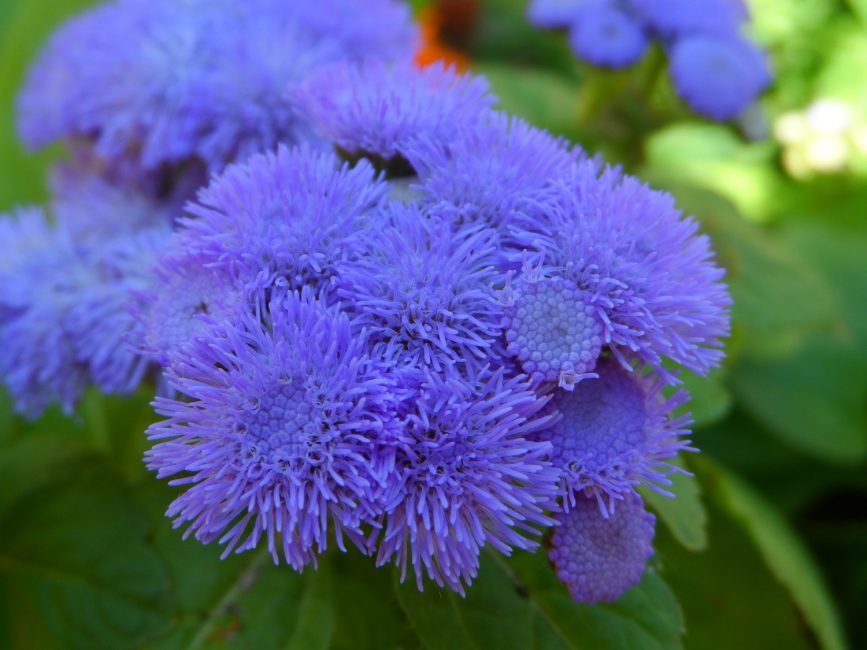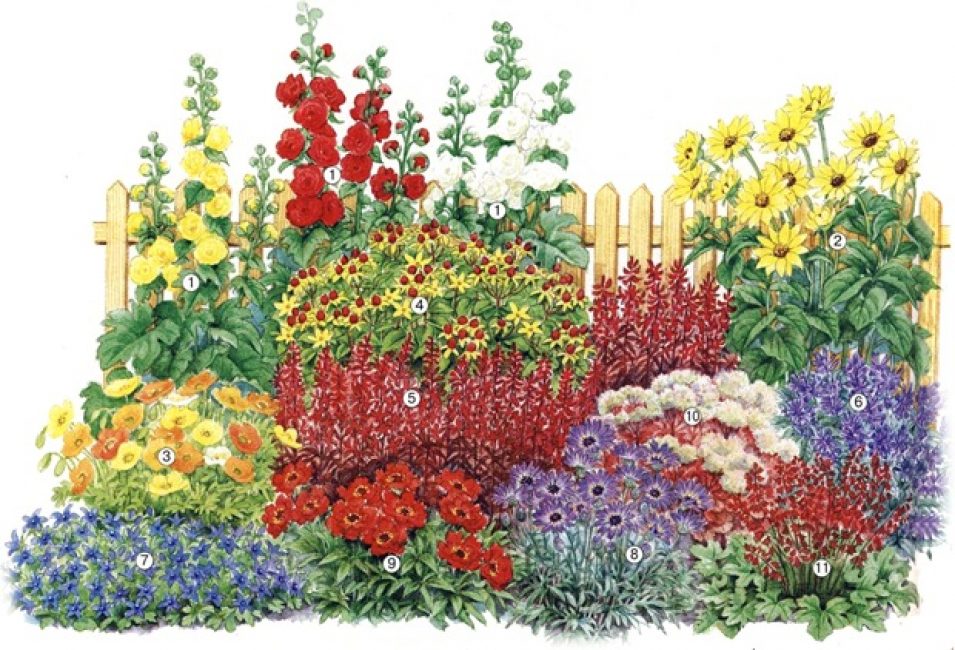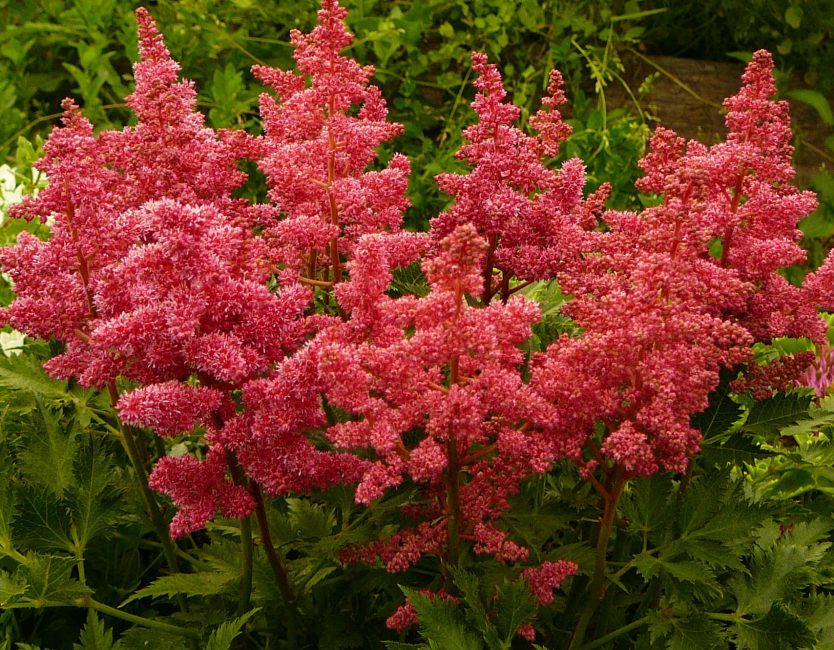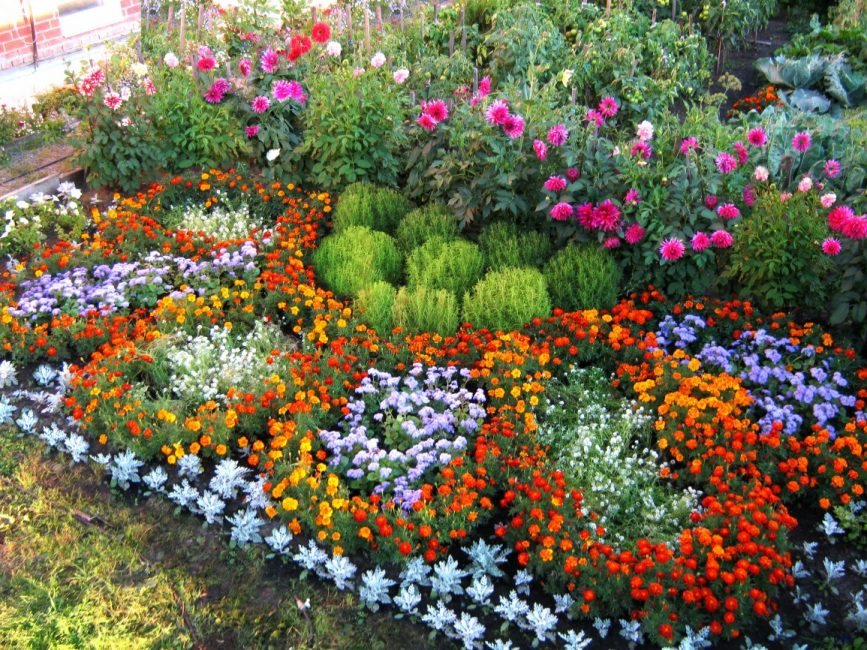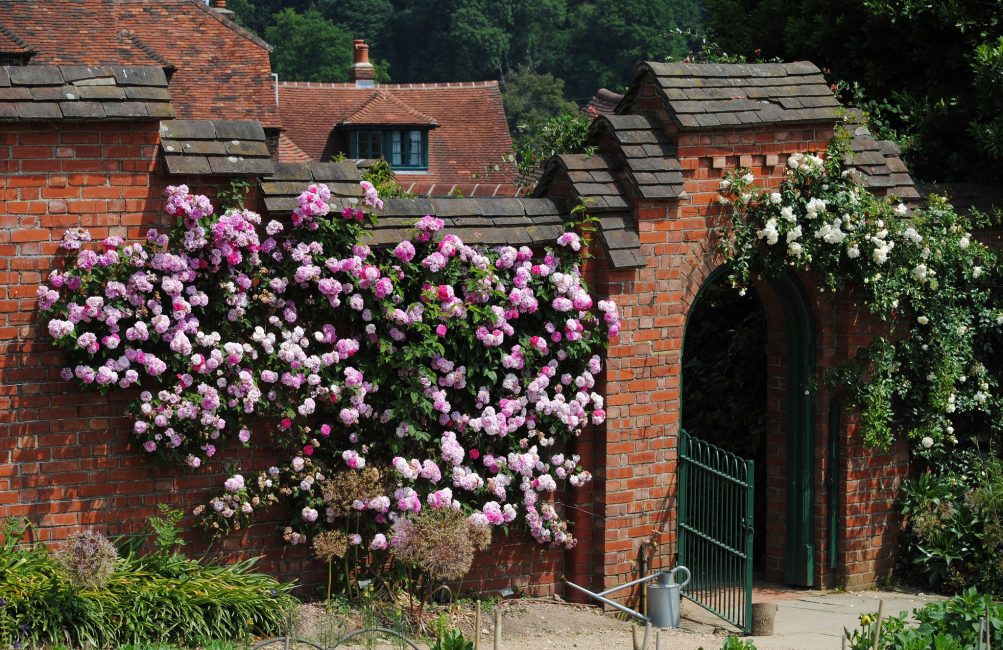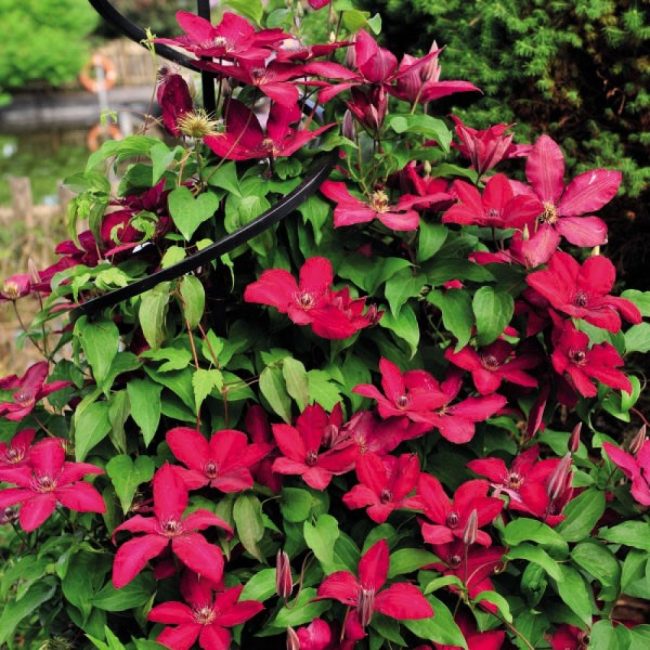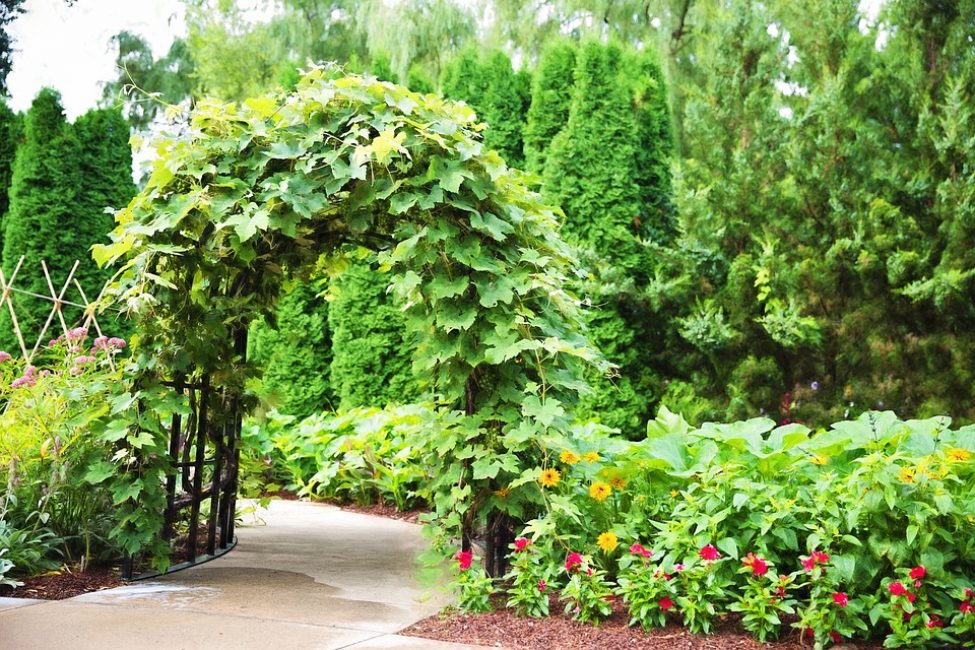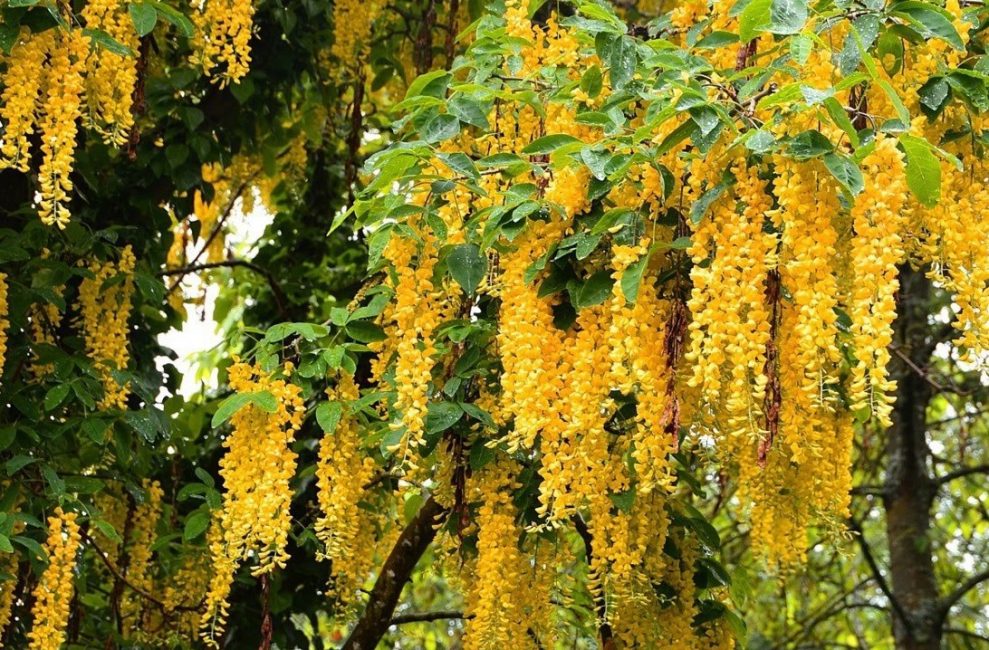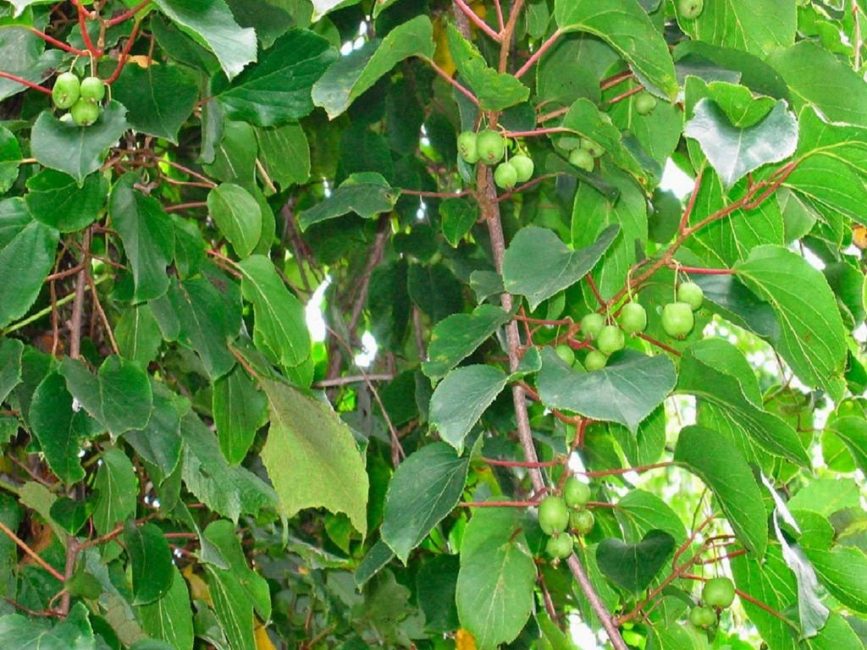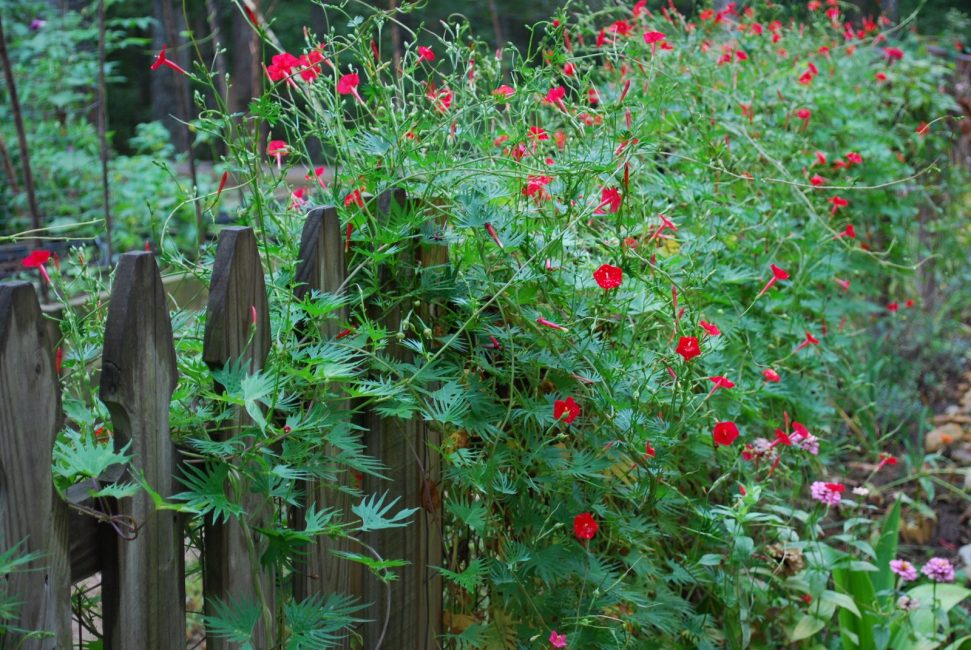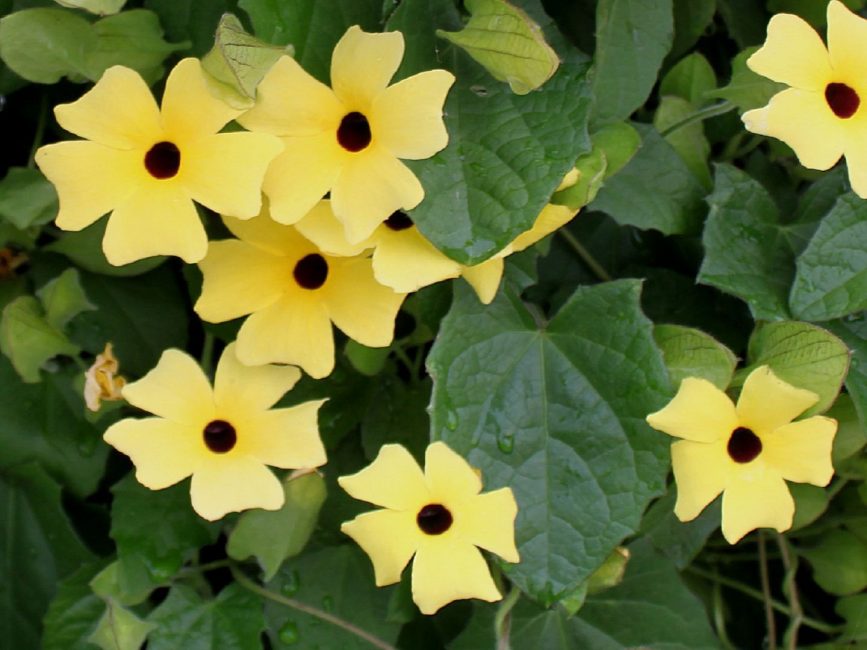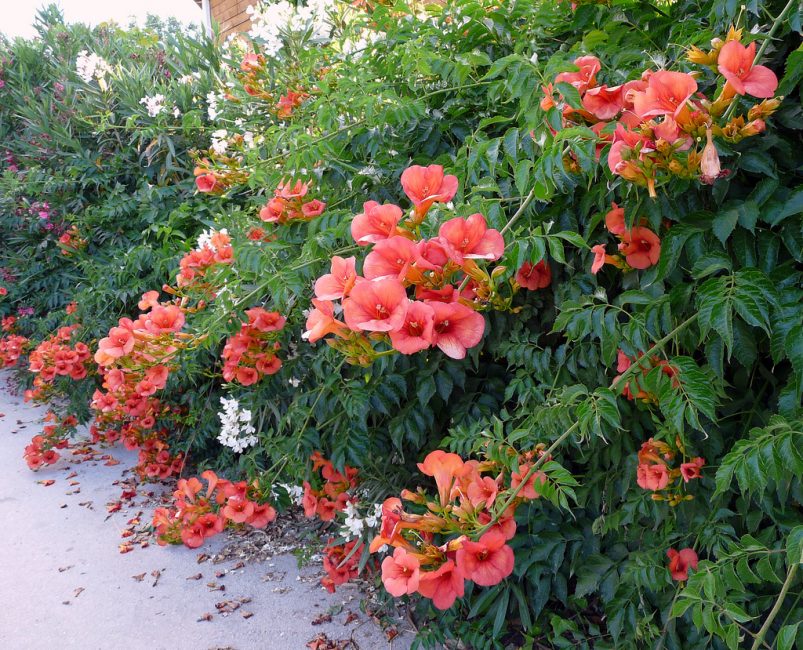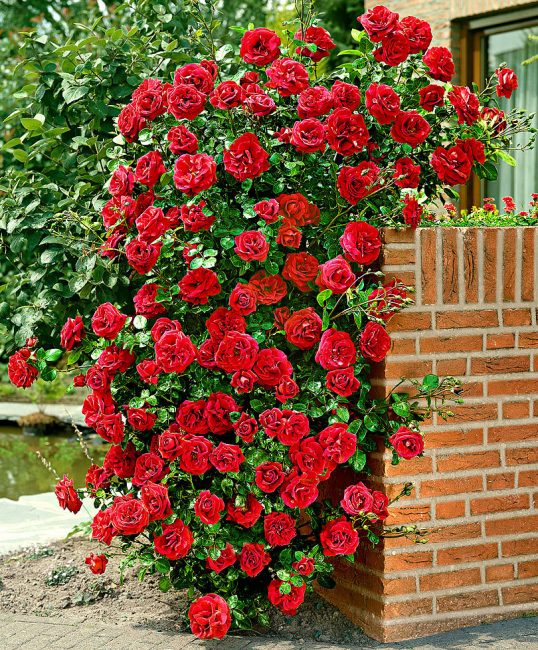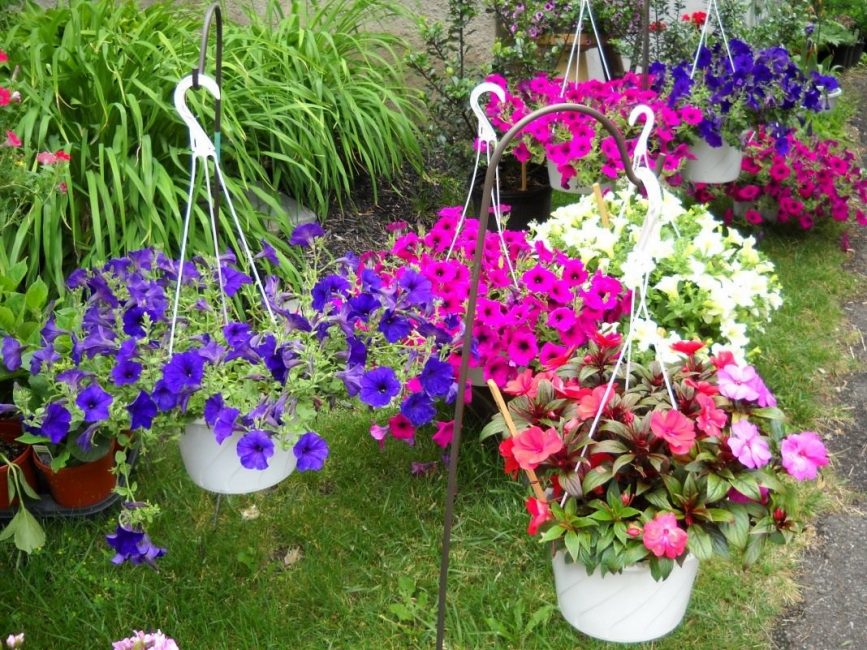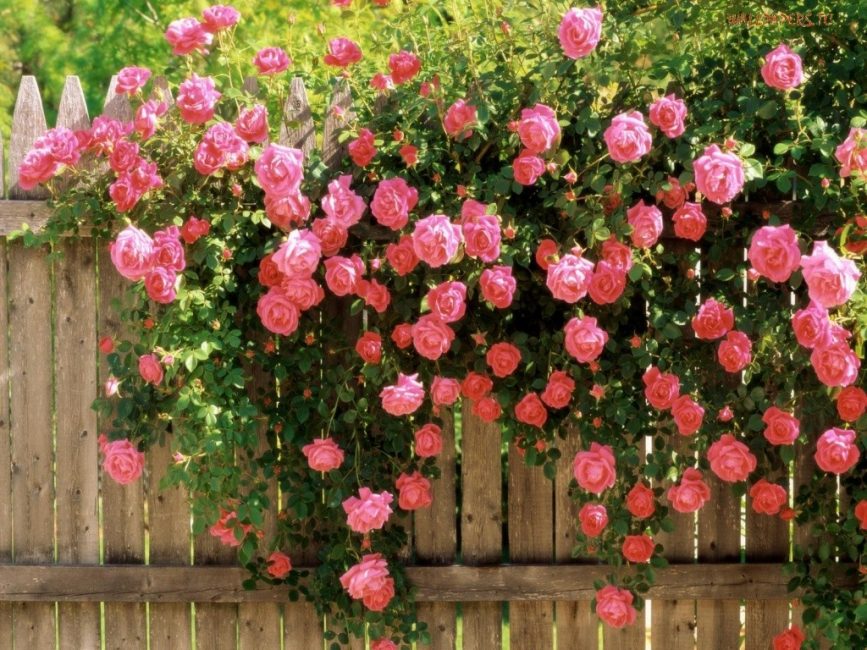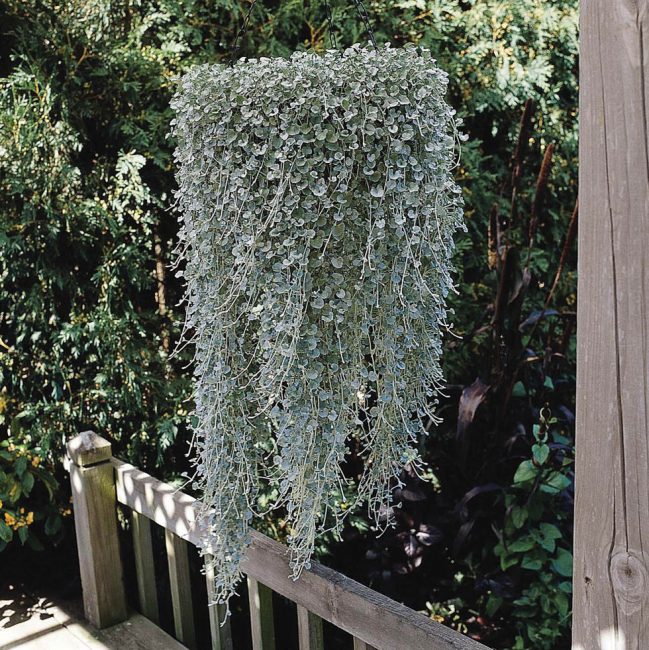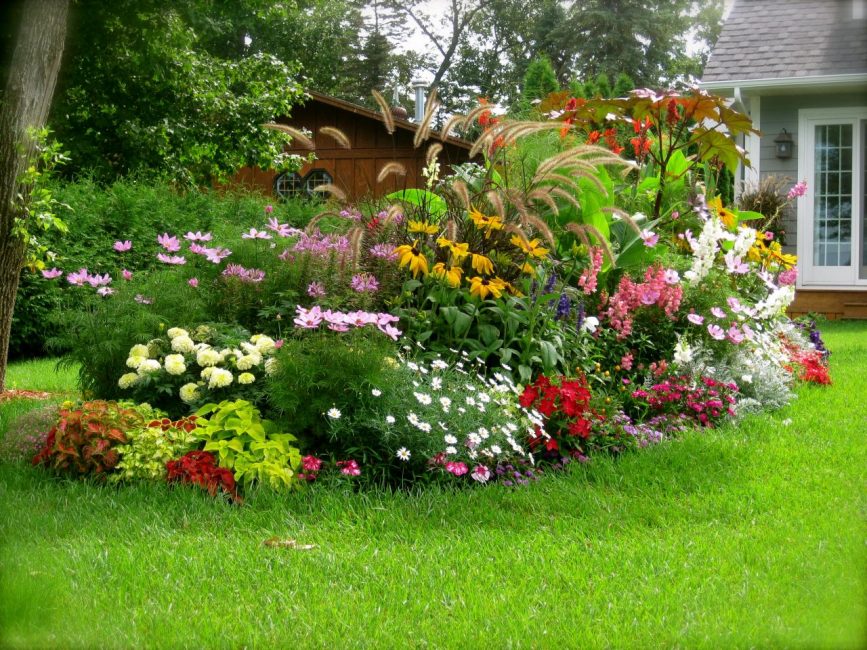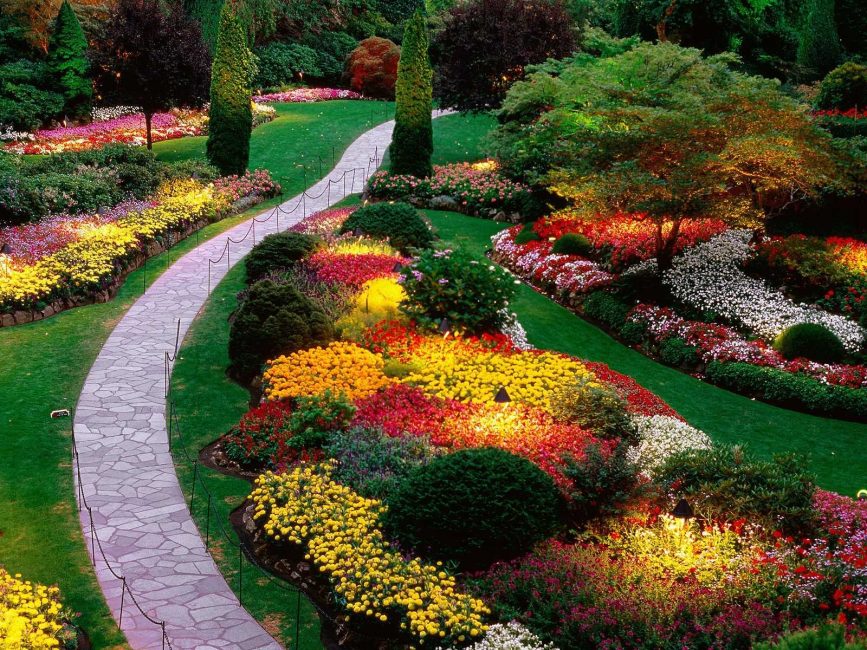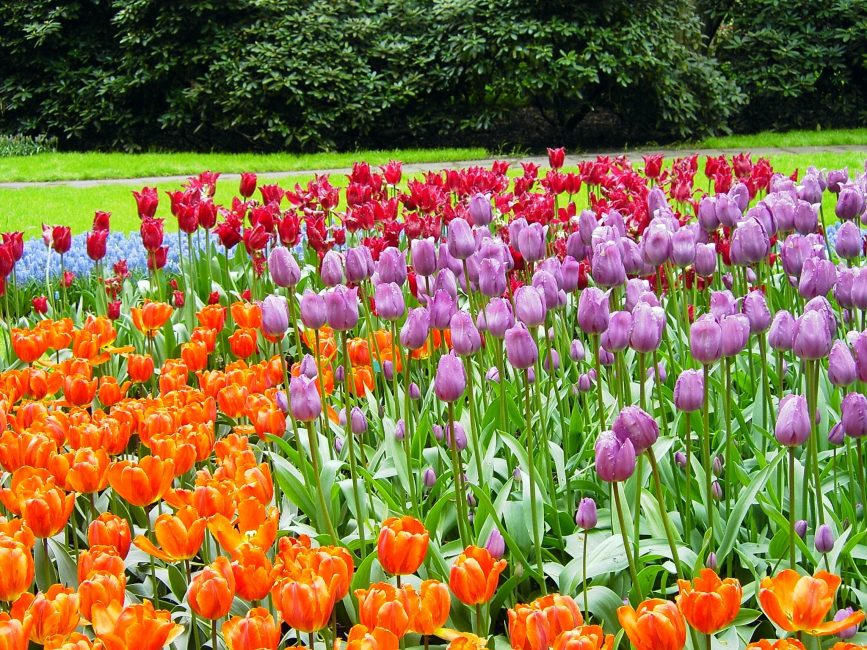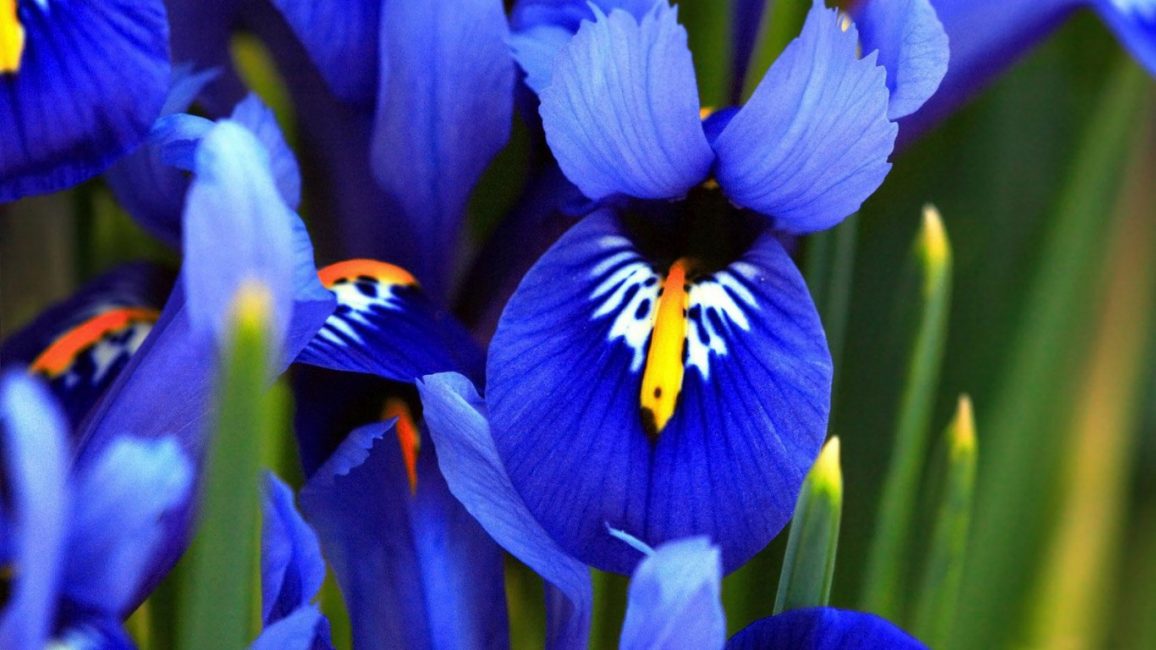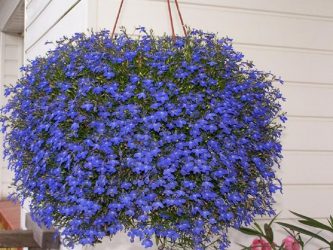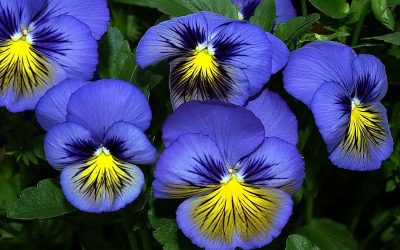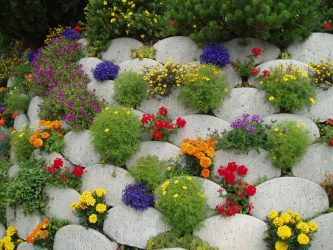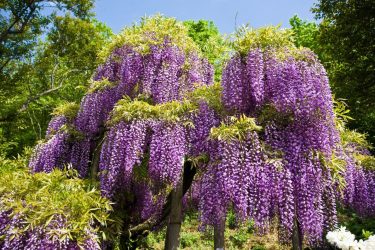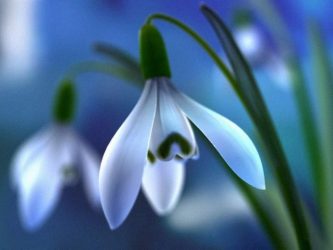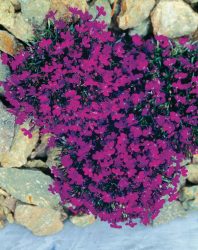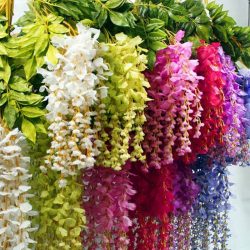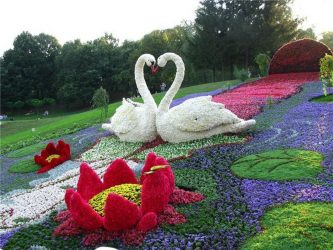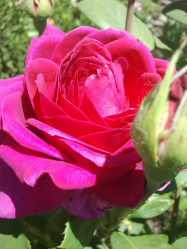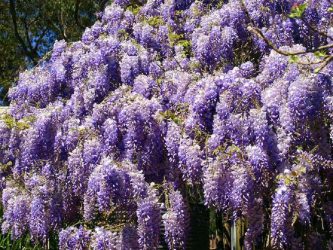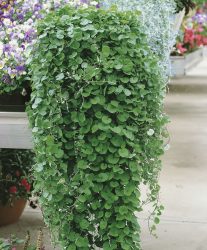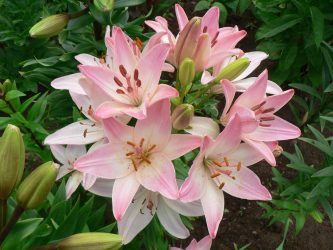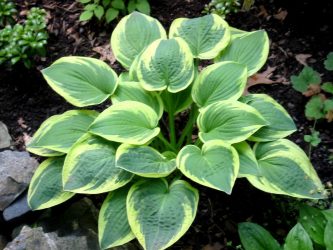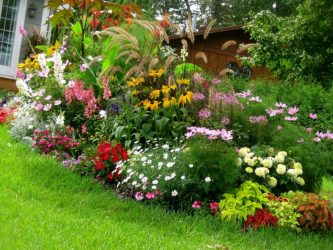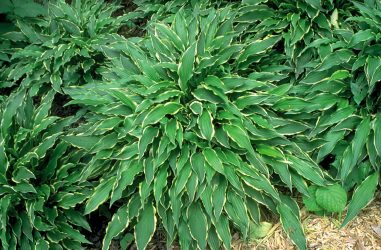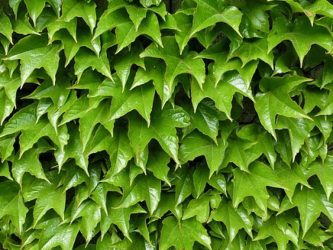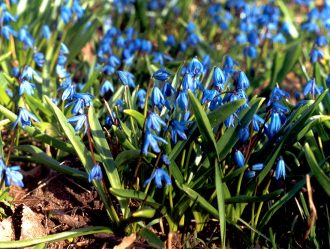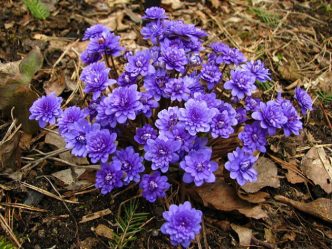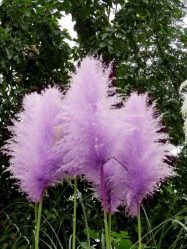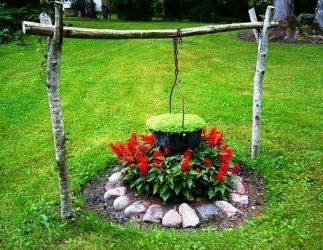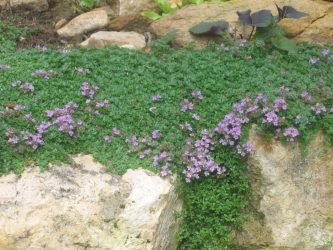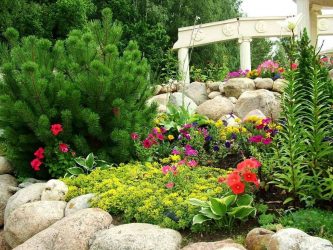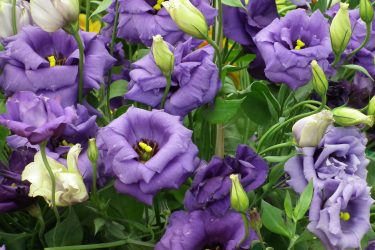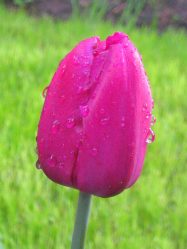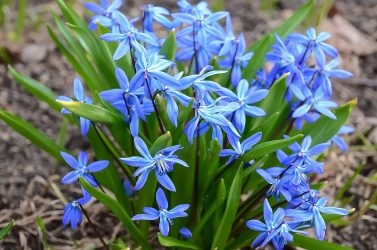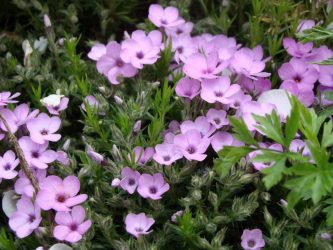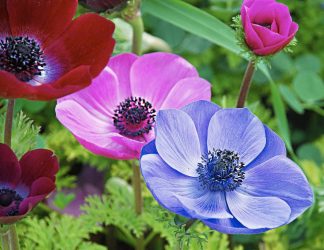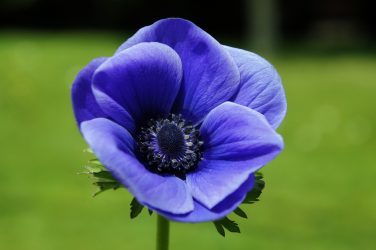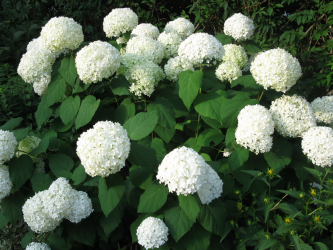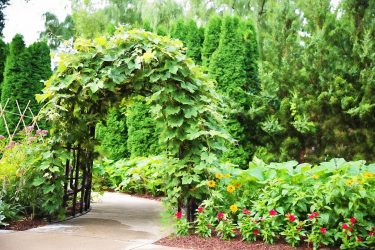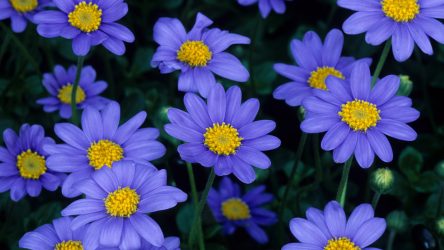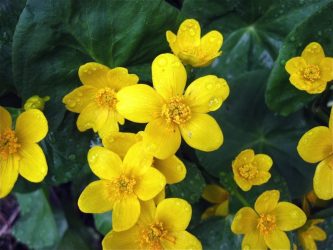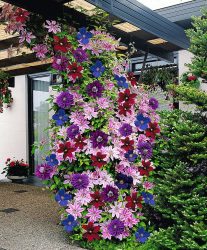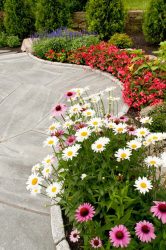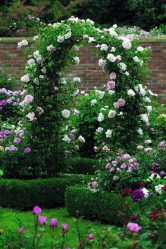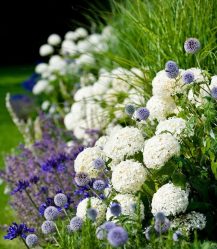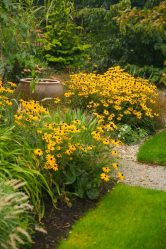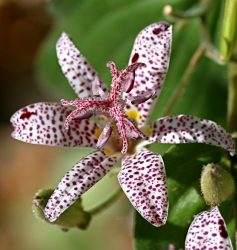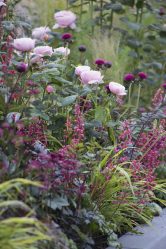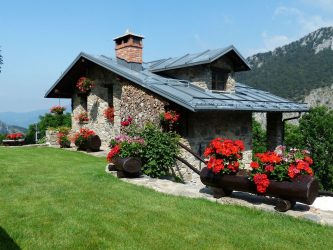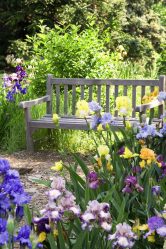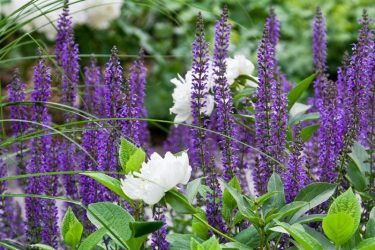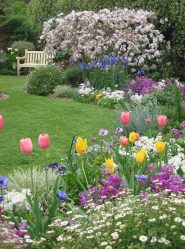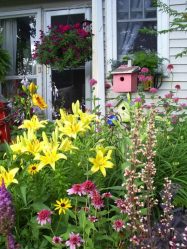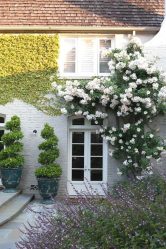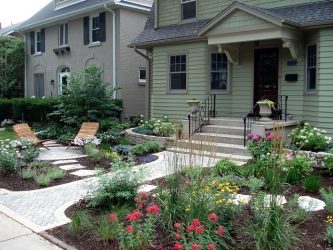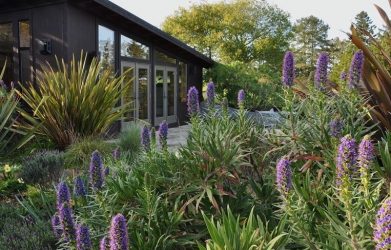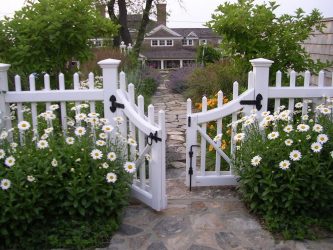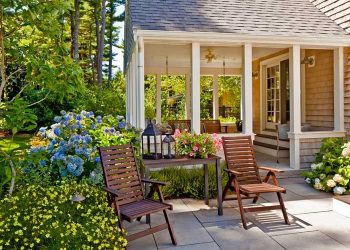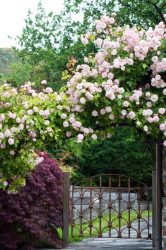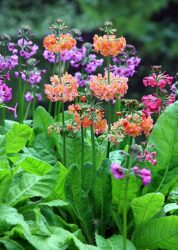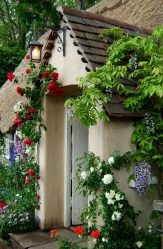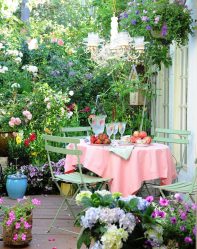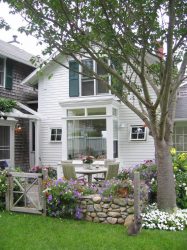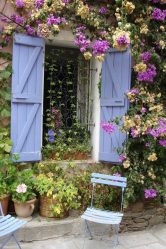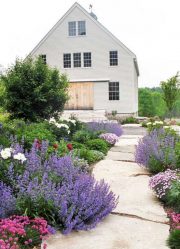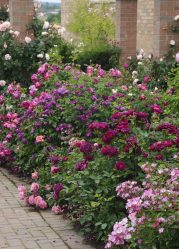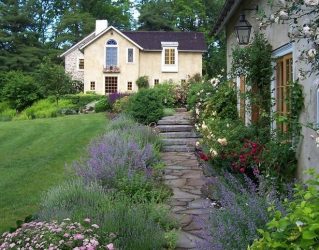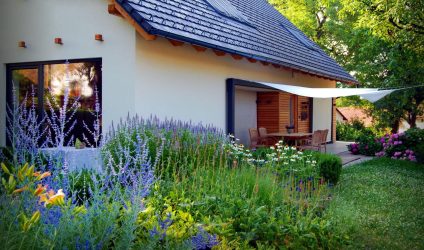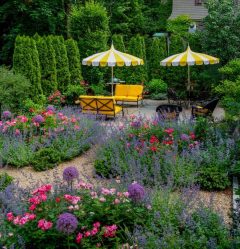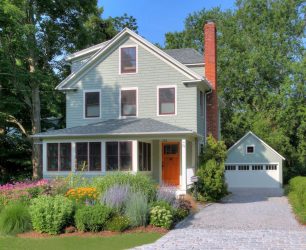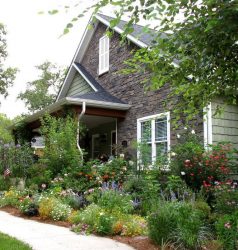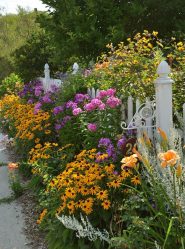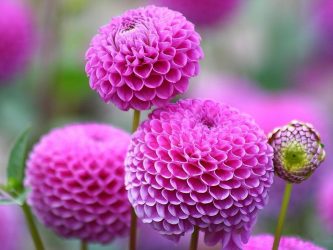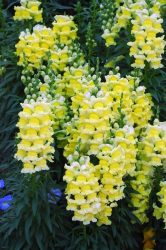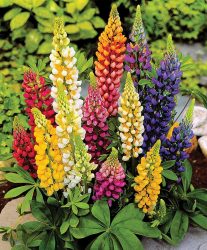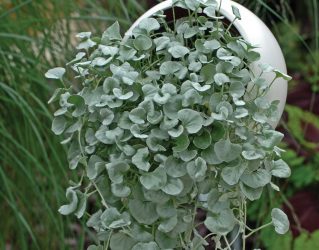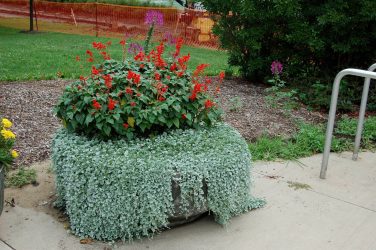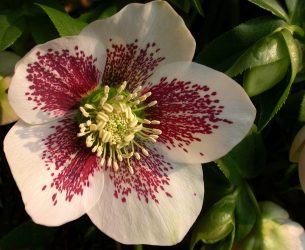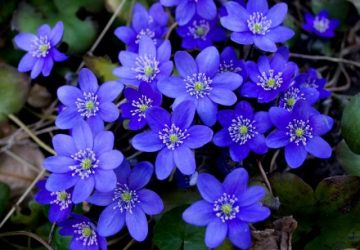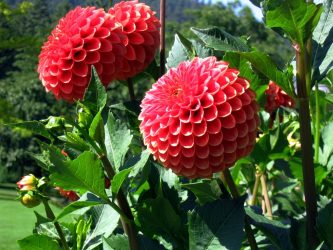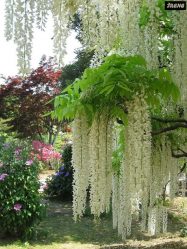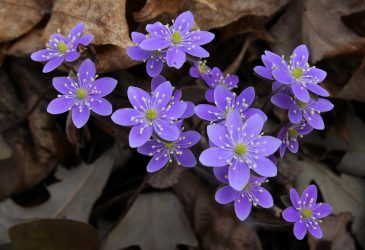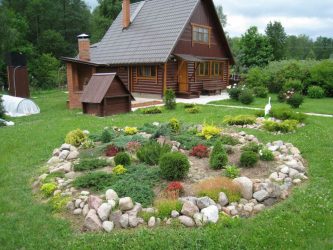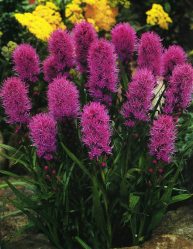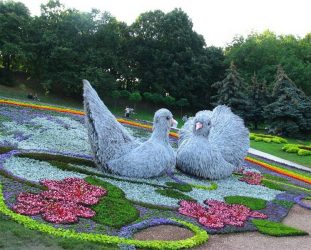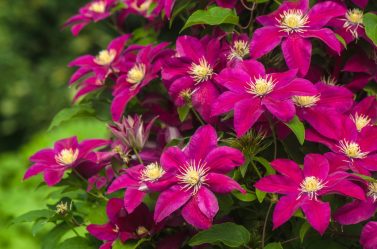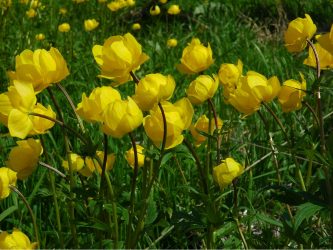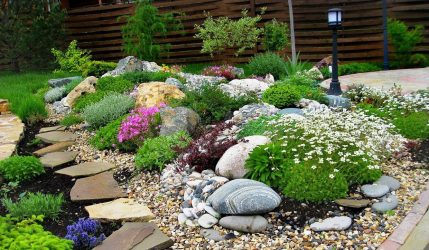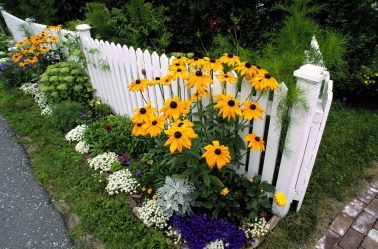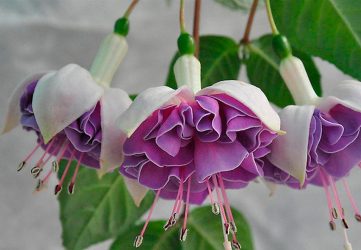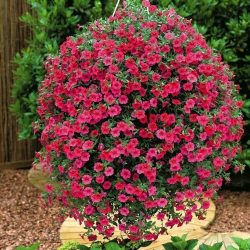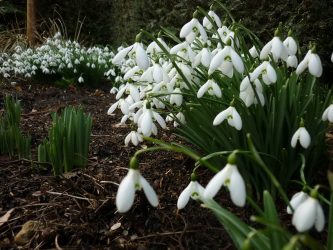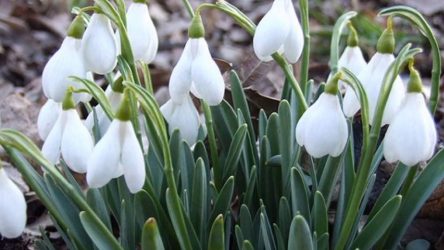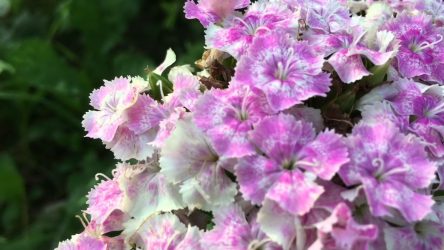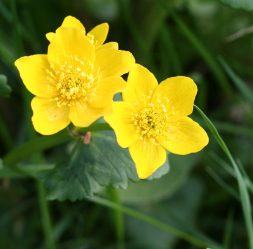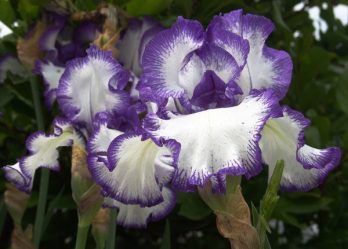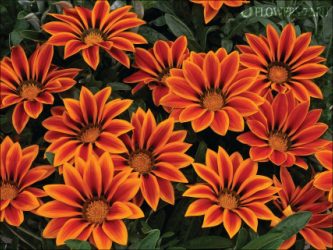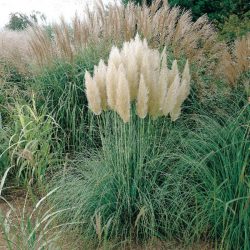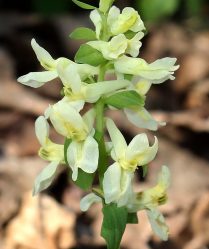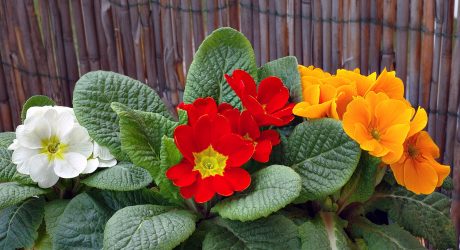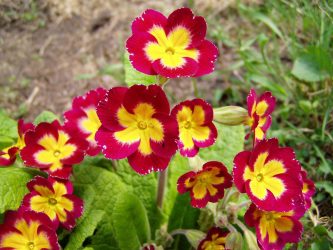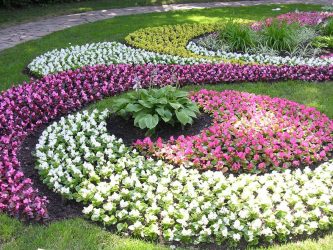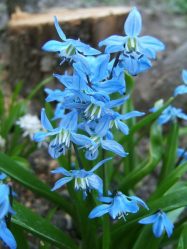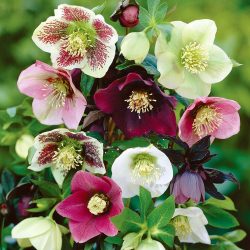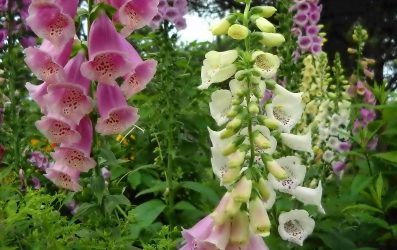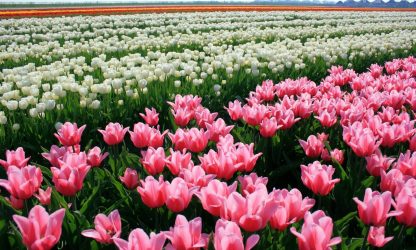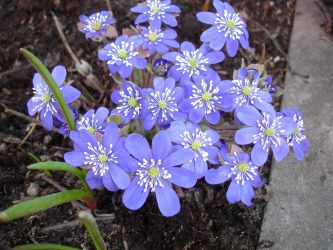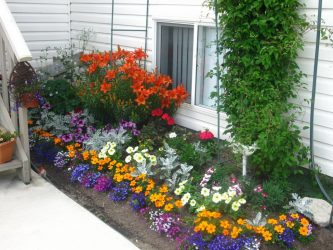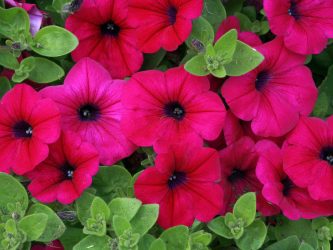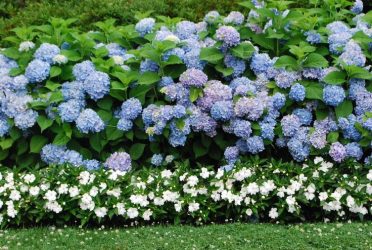
How to plant flowers in the country to give your summer cottage an incredible charm?
Content:
Landscape design cottages
At first glance it may seem that it is much easier to develop landscape design for a large suburban area than for a small one. But, in fact, this is far from the case. Having picked up the wrong way, or having misplaced them, you can visually “reduce” your already small, summer cottage.
In order for this not to happen, you need to follow a few simple tips:
- The first rule is the rejection of large buildings, trees and shrubs. Large plants take up a lot of space, from which it will seem that the dacha is quite “miserable”.
- It is necessary to abandon the high hedges, completely entwined with climbing flowers. If the site is completely fenced, plant a large number of flowers around the fence, it will be more like a cage than a place to rest.
- You should not plant in the country tall flowering trees. Because of them, the plot will be completely darkened, and most in such conditions will not be able to grow. You can, of course, plant the entire summer cottage with shade flowers. But most of them practically do not bloom, and also will not be able to grow if the soil is with a low level of acidity and humidity.
We make flower beds
To create a perfect must adhere to the following rules:
- varieties must be combined with each other not only in inflorescences, but in the form of leaves;
- harmoniously look different in shape inflorescences, leaves, but similar in shade;
- it is necessary to take into account the flowering period of each flower;
- tall plants are planted in the center or on the last tier, undersized - on the edges or on the curbs;
- in the center, the distance between plants should be large, closer to the edge - the density increases. Plants planted near the curb should be placed "carpet";
- It is not advisable to plant near a large number of varieties with different shades of inflorescences. So the flowerbed will look disharmonious;
- It is important to take into account the preferences in soil, irrigation, the amount of sunlight, the acidity of the soil.
Perennial varieties
Perennial flowers are a universal option for those who do not want to develop new planting patterns every year. In order to constantly bloom on the site plants need to pick up perennial varieties.
Varieties by flowering time are divided into several types:
- blooming in spring;
- blooming in summer;
- blooming before frost.
| Name of annual bloom | July | Aug. Sept | October |
|---|---|---|---|
| Aster | + | + | |
| Marigold | + | + | + |
| Dahlia | + | + | |
| Gladiolus | + | ||
| Celosia | + | + | + |
| Purslane | + | + | |
| Clarkia | + | + | |
| Hypospila | + | + | |
| Kosmeya | + | + | + |
| Lavertera | + | ||
| Snapdragon | + | + | |
| Sea lobularia | + | + | |
| Nasturtium | + | + | |
| Petunia | + | + | |
| Fragrant tobacco | + | ||
| Zinia | + | + |
Based on this table, you can pick up perennial varieties so that the plot is “blooming” from early spring to late autumn.
First of all it is:
- snowdrops (galantus);
- hellebore;
- scilla (scilla);
- anemone (anemone);
- crested crest;
- marshmallow;
- liverworm.
They all begin to bloom immediately after most of the snow has melted.
return to menu ↑Annual varieties
If with perennials, which can grow for several years in the same place without requiring a transplant, everything is clear, then annuals are another matter. Annuals will have to plant every year again.
On the one hand, this is an advantage, because if the flower does not like or does not look in the overall composition, then next year you can simply not plant it. But on the other hand, if it fits perfectly into the landscape design, you will have to annually cultivate this variety.
| Name of annual bloom | July | Aug. Sept | October |
|---|---|---|---|
| Aster | + | + | |
| Marigold | + | + | + |
| Dahlia | + | + | |
| Gladiolus | + | ||
| Celosia | + | + | + |
| Purslane | + | + | |
| Clarkia | + | + | |
| Hypospila | + | + | |
| Kosmeya | + | + | + |
| Lavertera | + | ||
| Snapdragon | + | + | |
| Sea lobularia | + | + | |
| Nasturtium | + | + | |
| Petunia | + | + | |
| Fragrant tobacco | + | ||
| Zinia | + | + |
But among the annuals rarely meet varieties that begin to bloom in early spring. Most often, the flowering period they begin in mid-summer and ends with the onset of the first frost.
return to menu ↑Proper bedding arrangement
Before you begin to engage directly in planting, it is necessary to graphically depict the pattern of future flower beds. This greatly simplifies the task and does not allow to make a mistake.
The second rule - it is necessary to take into account the characteristics of the varieties selected for planting. Shade-tolerant plants will not be able to grow in the sun, and light-loving plants are not recommended to be planted in dark areas. In addition, the composition of the soil is important. Some prefer not only "dark places", but also high humidity or acidity of the soil.
The easiest way is round. Even a beginner can handle it. For example, tall people can be planted in the center (this could be delphinium, roses, peonies, or phloxes). Next, undersized varieties of one species (balsam, flax or pansy) are planted.
Between these two stripes must leave a place for planting, which bloom throughout the summer (petunia, marigold, pelargonium).
According to this scheme, you can create any form. The main thing is fantasy.Also at the edges of the tracks you can plant low-growing with decorative grass.
Another universal version of flower arrangements is vertical. This option is suitable for those very small suburban areas. The easiest way to create a vertical flowerbed is a “wooden screen” with climbing flowers. You can put it together and plant some plants next to it, or use hedges.
You can also attach strong ropes to the roof of the house and fasten them to the ground. Especially this method is convenient if there is an open veranda. Flowers will create a shadow, and please their appearance.
return to menu ↑Making a vertical flower bed
- clematis;
- ipomoea purpurea;
- ivy;
- wisteria;
- actinidia;
- quamoclit;
- tunbergia winged;
- rhodochiton;
- Kampsis;
- curly honeysuckle;
- large-leaved kirkosan;
- curly rose.
For vertical, you can use hanging pots. Flowers that are planted in hanging pots are called ampelous.
Ampelnaya flowers:
- Lobelia;
- Petunia;
- Pelargonium (geranium);
- Verbena;
- Campanula;
- Viola;
- Ampelnaya fuchsia;
- Surfinia;
- Bakopa;
- Dichondra
The main advantage of hanging pots - they can be moved to another place at any time, thereby reviving your garden.
return to menu ↑Creating monochrome compositions
Monochrome flower arrangements are very simple in design. The main condition is that everyone should be in the same color scheme. You can use one or more varieties of plants.
As in the creation of a round flower bed, tall plants are located in the center, are low-growing. Along the edges you can plant ground covers.
In the event that flowers grow near the walls, fences or paths, the planting technique should be changed. High plant near the fence, and then you can plant low-growing plants.
return to menu ↑Contrast compositions
No less impressive will be the contrasting compositions. But it will be much more difficult to create one. First of all, it is necessary to understand exactly what colors are combined with each other, already on the basis of this, to plant.
For example, you can choose shades from one range. It may be yellow, red and orange. White, any other bright shades of inflorescences.
You can design as a mosaic. To do this, select several different varieties and plant each variety together (circles or any other figures). The height of the stems should be about the same. The result should be one big flower bed, consisting of small parts. Along the edges can be planted undersized greens (for example, the host).
return to menu ↑Flower arrangements in a neutral style
Neutral flower arrangements look very minimalist, spectacular. To create such a composition, you will need several flowering plants with soft highlights (pale pink, white, light yellow) and varieties that do not form inflorescences (fern, host). Such a flower bed will visually make the garden brighter, will give it freshness.
Neutral compositions can be created using roses. But in this case, it is desirable to give preference to pink, peach, white varieties. Together with roses, you can plant bushes of chubushnika or lilacs.
return to menu ↑Seating the most popular colors
Most often, in the suburban areas you can find roses, peonies, lilies or irises.
return to menu ↑Lilies
As a rule, lilies are planted in large groups. To the fore, you can put undersized Asiatic lilies, which bloom the very first. The second tier is tall varieties of lilies. Between these two tiers, you must leave space, plant other varieties of undersized (but they must be higher than the first tier of lilies). Phlox, freesia, lobelia will do. Behind high lilies you can plant peonies or hydrangeas.
return to menu ↑Hosta
Hosta universal, which is combined with any other varieties. As a rule, in flowerbeds it plays the role of a background, dilutes other blossoming ones. The best neighbors for the hosts will be undersized small-flowered plants. This may be lobelia, hyacinth, chrysanthemum, coleus, ageratum.
return to menu ↑Irises
Irises are suitable for creating monochrome flower beds with decorative cereal crops. By planting bergenia and irises of various shades you can get an unusual combination.
Hydrangea
Hortensia acts as an independent plant, and you can use it to create landscape design. The main rule - hydrangea should be located on the last tier of the flower bed and play the role of background for the rest. As neighbors you can use ornamental grasses, dahlias, roses, aconites, Colgaria autumn crocus and Buzulnik.
Hydrangea is perfect for registration of artificial reservoirs in the summer cottage.
return to menu ↑Pampas grass
Pampas grass (cortaderia) when improperly grown can become a weed to flood the entire area. After that, it will be very difficult to withdraw, but, despite this, it is very often used to design suburban areas.
Like hydrangea, cortaderia looks good in monochrome compositions. Together with the pampas grass in one composition will look good derbennik, miscanthus, groundwort, delphinium, gladioli.
On fertile soils, cortador can be planted along with geraniums, dahlias, rudbeckia or asters.
Flowerbed design in the country
Examples for beautiful design

